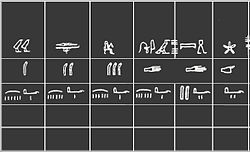This is an old revision of this page, as edited by Justlettersandnumbers (talk | contribs) at 01:06, 27 August 2011 (one hatnote enough). The present address (URL) is a permanent link to this revision, which may differ significantly from the current revision.
Revision as of 01:06, 27 August 2011 by Justlettersandnumbers (talk | contribs) (one hatnote enough)(diff) ← Previous revision | Latest revision (diff) | Newer revision → (diff) For other uses, see digit.
The digit or finger is an ancient and obsolete non-SI unit of measurement of length. It is an anthropic unit, originally based on the breadth of a human finger. It was a fundamental unit of length in the Ancient Egyptian, Mesopotamian, Hebrew, Ancient Greek and Roman systems of measurement.
In astronomy a digit is one twelfth of the diameter of the sun or the moon.
History
Ancient Egypt
Main article: Ancient Egyptian units of measurementThe digit, also called a finger or fingerbreadth, is an anthropic unit originally based on the breadth of a human finger. In Ancient Egypt it was the basic unit of subdivision of the cubit.
On surviving Ancient Egyptian cubit-rods, the royal cubit is divided into seven palms of four digits or fingers each. The royal cubit measured approximately 525 mm, so the length of the ancient Egyptian digit was about 19 mm.
| Name | Egyptian name | Equivalent Egyptian values | Metric equivalent | ||||
|---|---|---|---|---|---|---|---|
| Royal cubit |
|
7 palms or 28 digits | 525 mm | ||||
| Fist | 6 digits | 108 mm | |||||
| Hand | 5 digits | 94 mm | |||||
| Palm |
|
4 digits | 75 mm | ||||
| Digit |
|
1/4 palm | 19 mm |
Mesopotamia
Main article: Ancient Egyptian units of measurementAncient Hebrew system
Main article: Ancient Hebrew units of measurementAncient Greece
Main article: Ancient Greek units of measurementAncient Rome
Main article: Ancient Roman units of measurementBritain
Main article: English unitsA digit (lat. digitus, "finger"), when used as a unit of length, is usually a sixteenth of a foot or 3/4" (1.905 cm for the international inch). The width of an adult human male finger tip is indeed about 2 centimetres. In English this unit has mostly fallen out of use, as do others based on the human arm: finger (7/6 digit), palm (4 digits), hand (16/3 digits), shaftment (8 digits), span (12 digits), cubit (24 digits) and ell (60 digits).
It is in general equal to the foot-nail, although the term nail can also be used as 1/16 of yard and other units.
Astronomy
In astronomy a digit is, or was until recently, one twelfth of the diameter of the sun or the moon. This is found in the Moralia of Plutarch, XII:23, but the definition as exactly one twelfth of the diameter may be due to Ptolemy. Sosigenes of Alexandria had observed in the 1st century AD that on a dioptra, a disc with a diameter of 11 or 12 digits (of length) was needed to cover the moon.
See also
References
- ^ Hosch, William L. (ed.) (2010) The Britannica Guide to Numbers and Measurement New York, NY: Britannica Educational Publications, 1st edition. ISBN978-1615301089, p.203}}
- ^ Chisholm, Hugh (ed.) (1910–1911) Encyclopædia Britannica (11th edition) Cambridge: University Press, "digit"
- Selin, Helaine (ed.) (1997). Encyclopaedia of the History of Science, Technology and Medicine in non-Western Cultures. Dordrecht: Kluwer. ISBN 9780792340669.
{{cite book}}:|first=has generic name (help) - Lepsius, Richard (1865). Die altaegyptische Elle und ihre Eintheilung (in German). Berlin: Dümmler.
- Clagett, Marshall (1999). Ancient Egyptian Science, A Source Book. Volume 3: Ancient Egyptian Mathematics. Philadelphia: American Philosophical Society. ISBN 9780871692320.
- {Macdonald, A.M. (ed.) (1972) Chambers Twentieth Century Dictionary Edinburgh: W. & R. Chambers, "digit"
- Plutarchus Chaeronensis, Frank Cole Babbitt (trans.) (1957) Plutarch's Moralia: In fifteen volumes London: William Heinemann, Cambridge, Mass.: Harvard University Press, Volume XII p.144
- Neugebauer, Otto (1975) A History of Ancient Mathematical Astronomy Berlin: Springer, Volume 2, p.658